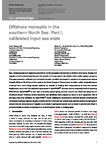Offshore monopile in the southern North Sea: Part I, calibrated input sea state
| dc.contributor.author | Edesess, Ariel | |
| dc.contributor.author | Kelliher, D | |
| dc.contributor.author | Borthwick, Alistair | |
| dc.contributor.author | Thomas, Gareth | |
| dc.date.accessioned | 2021-08-22T16:40:44Z | |
| dc.date.available | 2021-08-22T16:40:44Z | |
| dc.date.issued | 2017-12 | |
| dc.identifier.issn | 1741-7597 | |
| dc.identifier.issn | 1751-7737 | |
| dc.identifier.uri | http://hdl.handle.net/10026.1/17703 | |
| dc.description.abstract |
<jats:p> Safe, reliable access is an essential precondition for the successful maintenance of offshore wind farms. Access from vessels to wind turbines depends on the severity of the sea state in the vicinity of the turbine support structure. This paper presents a validation of a numerical boundary condition developed to reproduce the seasonal sea state at Teesside Offshore Wind Farm, off the coast of the UK. The boundary condition, called customSpectrum, was derived from wave energy spectra obtained by analysis of existing field measurements of wave free-surface displacement at the wind farm site and implemented in OpenFoam, the open-source computational fluid dynamics library. OpenFoam was then used to simulate typical spring, summer, autumn and winter sea states as uni-directional waves. Predicted surface elevations and significant wave heights were found to be in agreement with in situ buoy data, thus validating the OpenFoam model. Satisfactory agreement was achieved between analytical and numerically predicted spectral density functions for the horizontal and vertical water particle velocity components. It was found that the wave activity at Teesside is uni-modal in spring and autumn, and bi-modal in summer and winter. Extending the procedure to multi-directional waves in crossing seas is recommended. </jats:p> | |
| dc.format.extent | 122-132 | |
| dc.language | en | |
| dc.language.iso | en | |
| dc.publisher | Thomas Telford Ltd. | |
| dc.subject | maintenance & inspection | |
| dc.subject | mathematical modelling | |
| dc.subject | renewable energy | |
| dc.title | Offshore monopile in the southern North Sea: Part I, calibrated input sea state | |
| dc.type | journal-article | |
| dc.type | Journal Article | |
| plymouth.author-url | https://www.webofscience.com/api/gateway?GWVersion=2&SrcApp=PARTNER_APP&SrcAuth=LinksAMR&KeyUT=WOS:000447058200005&DestLinkType=FullRecord&DestApp=ALL_WOS&UsrCustomerID=11bb513d99f797142bcfeffcc58ea008 | |
| plymouth.issue | 3+4 | |
| plymouth.volume | 170 | |
| plymouth.publication-status | Published | |
| plymouth.journal | Proceedings of the Institution of Civil Engineers - Maritime Engineering | |
| dc.identifier.doi | 10.1680/jmaen.2017.14 | |
| plymouth.organisational-group | /Plymouth | |
| plymouth.organisational-group | /Plymouth/Faculty of Science and Engineering | |
| plymouth.organisational-group | /Plymouth/Faculty of Science and Engineering/School of Engineering, Computing and Mathematics | |
| plymouth.organisational-group | /Plymouth/Users by role | |
| plymouth.organisational-group | /Plymouth/Users by role/Academics | |
| dc.identifier.eissn | 1751-7737 | |
| dc.rights.embargoperiod | Not known | |
| rioxxterms.versionofrecord | 10.1680/jmaen.2017.14 | |
| rioxxterms.licenseref.uri | http://www.rioxx.net/licenses/all-rights-reserved | |
| rioxxterms.type | Journal Article/Review |


